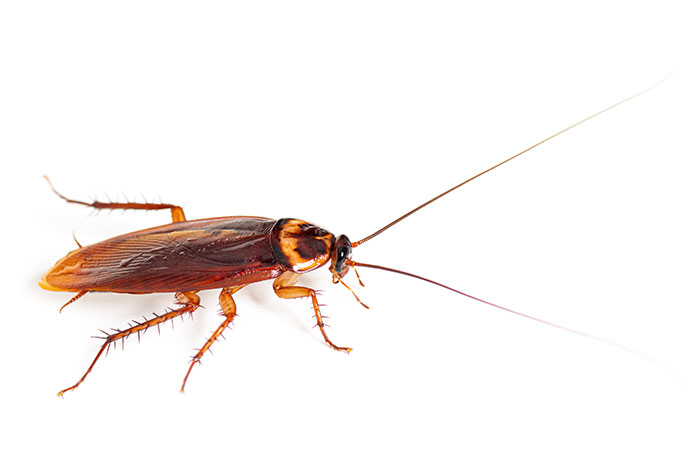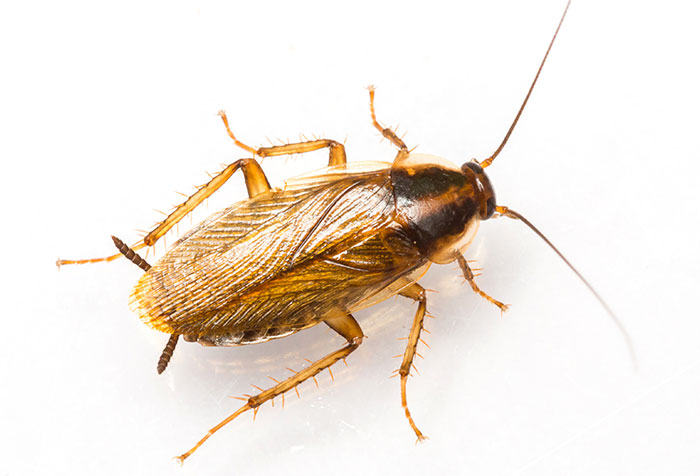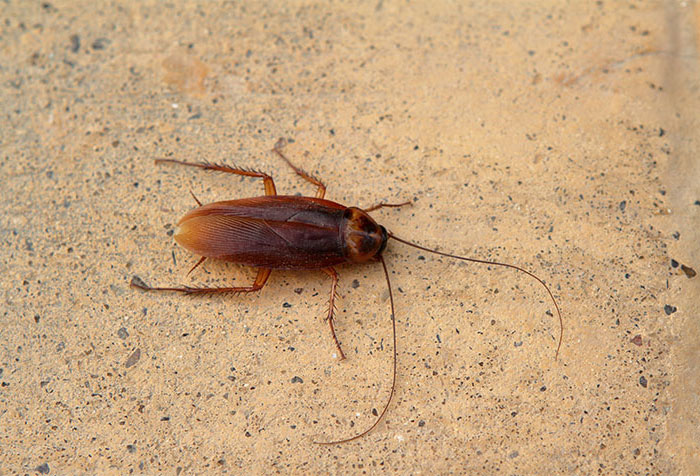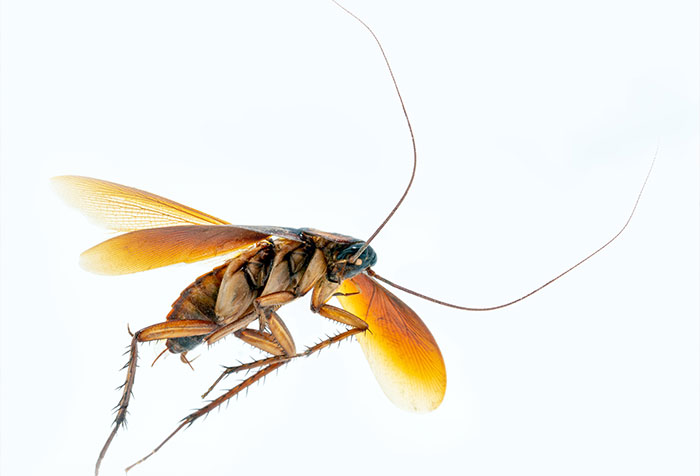Have you ever encountered cockroaches in your home in Texas?
You’re not alone.
Texas, with its warm climate, is a breeding ground for various species of cockroaches.
These pests are not just an annoying presence; they can pose serious health risks.
This guide will help you identify different types of cockroaches in Texas, understand their potential health implications, and provide tips on how to prevent an infestation.
Key Takeaways
- There are four main types of cockroaches in Texas: the American cockroach, German cockroach, Oriental cockroach, and flying cockroach.
- Most of these pests prefer to inhabit warm, damp areas like kitchens and bathrooms, and can also be found outside.
- The best way to prevent cockroaches is to keep your home clean and sealed, but if a problem arises, it’s best to contact a pest control professional as soon as you can.
Main Types of Cockroaches in Texas: Identification, Diet, Habitats, and Health Risks
| Name of Cockroach | Identifiable Traits | Diet | Where you might find them | Health Risk |
| American Cockroach | 2″ long, reddish brown with large body | Cosmetic, milk, soap, fruit, plant shoots, wallpaper, etc. | Prefer warm and humid environments like sewers, meter boxes, storm drains, etc. | Can spread more than 33 kinds of bacteria and parasites |
| German Cockroach | ½” long, light brown | Starches, sweets, grease, meat | Prefer living in any food preparation or storage areas | Can transmit many diseases, including coliform bacteria, hepatitis, and Staphylococcus and Streptococcus bacteria |
| Oriental Cockroach | 1 ¼” long, nearly black | Food, garbage, decaying organic matter | Prefers basements, garages, vegetation, woodpiles | Can cause diarrhea, salmonella, dysentery, and other diseases |
| Flying Cockroach | Decaying organic matter and food crumbs | Kitchens, bathrooms,heating ducts | Can cause allergic and asthmatic reactions |
American Cockroach

The American cockroach is one of the largest species of cockroaches, measuring up to 1.6 inches in length. It is reddish brown in color and has a pair of long wings that allow it to fly short distances. Male American cockroaches also have two small appendages on their abdomens called cerci. These appendages are used to sense movement and air currents, helping the cockroach avoid predators.
American cockroaches are omnivorous, meaning they’ll eat just about anything. They’re particularly fond of starchy foods like bread and pasta as well as sweets like candy and cake.
However, these insects are also known to eat non-food items like leather and book bindings. In fact, American cockroaches have been known to nibble on the occasional human hair or fingernail!
Because they prefer warm, humid environments, American cockroaches are commonly found in basements, crawl spaces, and sewers. They can also be found outdoors in mulch piles or under dead leaves. If an American cockroach finds its way into your home, you’re likely to find it in your kitchen or bathroom since these areas provide ample food and water sources as well as access to hiding places.
German Cockroach

German cockroaches are small insects that measure just over 1/2 an inch long. They are light brown in color and have two dark stripes on their backs. German cockroaches are good climbers and can move quickly. They are most active at night when they come out to forage for food.
German cockroaches are scavengers and will eat just about anything. They are particularly fond of starchy foods, sweet foods, and grease. German cockroaches are often found in kitchens where they can easily access food sources.
German cockroaches typically live in close proximity to humans. They are often found in homes, restaurants, hotels, and other commercial buildings. German cockroaches can enter buildings through cracks and crevices in the foundation or by hitchhiking on luggage, boxes, or other items that are brought inside. Once they’re inside, German cockroaches will hide in dark places like behind appliances or under furniture.
German cockroaches are capable of carrying a host of diseases that pose a serious threat to human health. These diseases include salmonella, dysentery, typhoid fever, and leprosy. German cockroaches can also trigger asthma attacks in people who suffer from this condition.
Oriental Cockroach 
Oriental cockroaches are easily identifiable thanks to their glossy black bodies and long, slender antennae. They’re also one of the largest types of cockroaches, measuring in at around 1-2 inches in length.
Oriental cockroaches are omnivores, which means they’ll pretty much eat anything they can get their hands on. In the wild, they typically feed on things like decaying leaves and wood. But in your home, they’ll happily feast on things like crumbs, garbage, or even pet food that’s been left out. If you have an infestation, it’s important to clean up any food that’s been left out so as not to attract more roaches.
Oriental cockroaches are most commonly found in dark and damp areas like basements or crawl spaces. They also tend to congregate near sources of water like pipes or drains. If you suspect there might be roaches in your home, be sure to check these areas first.
Flying Cockroach

Flying cockroaches range in size from 1/2 inch to 3 inches long. They are dark brown or black in color and have wings.
Flying cockroaches are scavengers and will eat just about anything. They are most commonly found near sources of food and water.
These pests are found all over the world. They are most commonly found in tropical climates. When indoors, they prefer locations like kitchens, bathrooms, and heating ducts, where the temperature is warm and food sources are plenty.
Pennsylvania Wood Cockroach
The Pennsylvania Wood Cockroach, which can be found throughout Texas, is typically around an inch in length with males being slightly larger than females.
They are characterized by their chestnut brown color, and the males have a yellowish band around the edge of their wings. Their diet mostly consists of decaying organic matter, but they are not averse to feeding on starchy materials and sweet substances.
While these cockroaches prefer outdoor habitats, such as in piles of firewood or beneath bark, they can sometimes venture into homes, usually by accident.
Though they do not pose significant health risks to humans, they can be a nuisance due to their occasional indoor presence.
Australian Cockroach
The Australian Cockroach, despite its name, is prevalent in Texas and other southern states. This species can grow up to 1.25 inches in length and is easily identifiable by its dark brown color, with pronounced yellow stripes along the edge of its wings.
Australian Cockroaches are omnivorous and prefer decaying organic matter but can eat household items like books and clothing. They are usually found outdoors in leaf piles or under tree bark, but they can also enter homes in search of warmth and food.
Australian Cockroaches can be a health concern as they are known carriers of bacteria and pathogens due to their foraging habits.
Surinam Cockroach
The Surinam Cockroach is a smaller species, measuring only up to 1 inch in length. They have a dark brown or black body with a shiny, reddish-brown pronotum.
They primarily feed on plant material, making them a particular problem for gardeners. Their preferred habitat includes compost piles, leaf litter, and mulch, and they rarely venture indoors.
While they aren’t directly associated with significant health risks, they can cause considerable damage to vegetation and are often considered a nuisance pest.
Smoky Brown Cockroach
The Smoky Brown Cockroach is a common sight in Texas, growing up to 1.5 inches in length. They have a uniform dark brown or mahogany color, making them easily recognizable.
These omnivorous cockroaches are not picky eaters and can consume any organic food source available, including decaying matter.
Typically, they inhabit damp and dark areas like tree holes, leaf litter, and mulch but can find their way into houses in search of food.
They can carry several types of bacteria and parasites, posing potential health risks if they contaminate food or surfaces in homes.
Asian Cockroach
The Asian Cockroach, while relatively new to Texas, has become widespread. They look remarkably similar to German Cockroaches, being approximately 0.5 to 0.6 inches long and light brown in color.
However, unlike their German counterparts, Asian Cockroaches are attracted to brightly lit areas and have strong flight capabilities. Their diet mainly consists of foods and beverages, garbage, and decaying organic matter.
They usually inhabit outdoor areas with mulch and leaf litter but can be attracted to light sources within homes. Asian Cockroaches are considered a significant pest due to their potential to spread diseases and cause allergic reactions.
Is It Normal To Have Cockroaches Im Your Home In Texas?
In Texas, given the region’s climate and environmental conditions, it is not uncommon to encounter cockroaches in your home.
The warm and humid climate in Texas creates an ideal environment for many types of cockroaches, like the German, American, Oriental, and even the invasive Asian Cockroach.
These pests can easily enter homes in search of food, water, and shelter, especially during extreme weather conditions or changes in season. While their presence may be somewhat common, it is not something to be ignored. Cockroaches can pose health risks as they are known to spread bacteria and cause allergic reactions.
Therefore, if you notice a cockroach infestation in your home, it’s recommended to take immediate steps for their removal and prevention, either through home remedies, pest control products, or professional pest control services.
How Can I Prevent Cockroaches?
Cockroaches are attracted to food, water, and shelter. That means the first step in preventing cockroaches is to eliminate their food sources.
Keep your kitchen clean by washing dishes after meals, sweeping and mopping regularly, and storing food in airtight containers. If possible, vacuum seal your pantry items like flour and sugar. You should also take out the trash regularly and keep your garbage cans clean and covered.
Another way to prevent cockroaches is to eliminate their water sources. Fix any leaks in your plumbing and make sure there is no standing water anywhere in your home. Cockroaches can live for months without food, but they will only survive for about a week without water.
Finally, make it difficult for cockroaches to find shelter in your home. Close up any cracks or crevices where they might be able to sneak inside. Keep your basement and attic well ventilated and free of clutter. Store boxes off the ground, and if possible, seal them in plastic bags. By making it difficult for cockroaches to find food, water, and shelter, you can prevent them from taking up residence in your home.
I Think I Have a Cockroach Infestation. What’s Next?
Finding a cockroach in your home is enough to make even the strongest person cringe. But seeing one cockroach often means there are many more that you can’t see. If you think you have a cockroach problem, don’t wait to take action. Keep reading to learn what you should do if you have a cockroach infestation.
Certain telltale signs indicate that you may have a cockroach problem. If you see one or more of the following, it’s time to call a pest control professional:
- Cockroaches during the day: Cockroaches are nocturnal creatures, so if you see them scurrying around during the daytime, it’s a good indicator that there is a nest nearby.
- Cockroaches in your food: If you see cockroaches near your food or in your pantry, it means they’ve been feeding on your food and contamination is possible.
- Droppings: Cockroaches leave behind droppings that look like black pepper or coffee grounds. These droppings can contain harmful bacteria that can cause dysentery or diarrhea in humans.
- Egg casings: Female cockroaches lay egg casings that are dark brown or black and look like flattened capsules. Each casing holds anywhere from 10 to 40 eggs, so finding just one is enough to confirm an infestation.
- Bad smell: A pungent, musty smell is another sign that cockroaches have taken up residence in your home. This smell is caused by the oils they secrete and deposits they leave behind as they travel through your home.